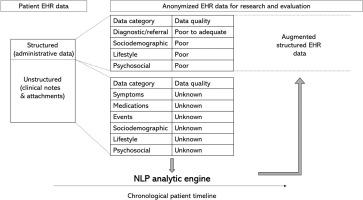当前位置:
X-MOL 学术
›
J. Biomed. Inform.
›
论文详情
Our official English website, www.x-mol.net, welcomes your
feedback! (Note: you will need to create a separate account there.)
Maximizing the use of social and behavioural information from secondary care mental health electronic health records.
Journal of Biomedical informatics ( IF 4.0 ) Pub Date : 2020-05-05 , DOI: 10.1016/j.jbi.2020.103429 S M Goodday 1 , A Kormilitzin 2 , N Vaci 2 , Q Liu 2 , A Cipriani 2 , T Smith 3 , A Nevado-Holgado 2
Journal of Biomedical informatics ( IF 4.0 ) Pub Date : 2020-05-05 , DOI: 10.1016/j.jbi.2020.103429 S M Goodday 1 , A Kormilitzin 2 , N Vaci 2 , Q Liu 2 , A Cipriani 2 , T Smith 3 , A Nevado-Holgado 2
Affiliation

|
PURPOSE
The contribution of social and behavioural factors in the development of mental health conditions and treatment effectiveness is widely supported, yet there are weak population level data sources on social and behavioural determinants of mental health. Enriching these data gaps will be crucial to accelerating precision medicine. Some have suggested the broader use of electronic health records (EHR) as a source of non-clinical determinants, although social and behavioural information are not systematically collected metrics in EHRs, internationally.
OBJECTIVE
In this commentary, we highlight the nature and quality of key available structured and unstructured social and behavioural data using a case example of value counts from secondary mental health data available in the UK from the UK Clinical Record Interactive Search (CRIS) database; highlight the methodological challenges in the use of such data; and possible solutions and opportunities involving the use of natural language processing (NLP) of unstructured EHR text.
CONCLUSIONS
Most structured non-clinical data fields within secondary care mental health EHR data have too much missing data for adequate use. The utility of other non-clinical fields reported semi-consistently (e.g., ethnicity and marital status) is entirely dependent on treating them appropriately in analyses, quantifying the many reasons behind missingness in consideration of selection biases. Advancements in NLP offer new opportunities in the exploitation of unstructured text from secondary care EHR data particularly given that clinical notes and attachments are available in large volumes of patients and are more routinely completed by clinicians. Tackling ways to re-use, harmonize, and improve our existing and future secondary care mental health data, leveraging advanced analytics such as NLP is worth the effort in an attempt to fill the data gap on social and behavioural contributors to mental health conditions and will be necessary to fulfill all of the domains needed to inform personalized interventions.
中文翻译:

最大限度地利用二级保健心理健康电子健康记录中的社会和行为信息。
目的社会和行为因素对精神健康状况的发展和治疗效果的贡献得到广泛支持,但是关于心理健康的社会和行为决定因素的人口水平数据来源薄弱。扩大这些数据差距对于加速精密医学至关重要。一些人提出,尽管国际上还没有系统地收集EHR中的社会和行为信息,但更广泛地使用电子健康记录(EHR)作为非临床决定因素。目的在本评论中,我们以英国临床记录互动搜索(CRIS)数据库中来自英国的二级精神卫生数据中的价值计数为例,重点介绍了关键的可用结构化和非结构化社会与行为数据的性质和质量;强调使用此类数据的方法学挑战;以及涉及使用非结构化EHR文本的自然语言处理(NLP)的可能解决方案和机会。结论二级保健精神卫生EHR数据中的大多数结构化非临床数据字段缺少太多数据,无法充分利用。半一致报道的其他非临床领域(例如种族和婚姻状况)的效用完全取决于在分析中对它们的适当处理,并考虑选择偏倚来量化缺失背后的许多原因。NLP的进步为利用二级医疗EHR数据中的非结构化文本提供了新的机会,特别是考虑到大量患者都有临床注释和附件,并且临床医生通常会完成这些注释。
更新日期:2020-05-05
中文翻译:

最大限度地利用二级保健心理健康电子健康记录中的社会和行为信息。
目的社会和行为因素对精神健康状况的发展和治疗效果的贡献得到广泛支持,但是关于心理健康的社会和行为决定因素的人口水平数据来源薄弱。扩大这些数据差距对于加速精密医学至关重要。一些人提出,尽管国际上还没有系统地收集EHR中的社会和行为信息,但更广泛地使用电子健康记录(EHR)作为非临床决定因素。目的在本评论中,我们以英国临床记录互动搜索(CRIS)数据库中来自英国的二级精神卫生数据中的价值计数为例,重点介绍了关键的可用结构化和非结构化社会与行为数据的性质和质量;强调使用此类数据的方法学挑战;以及涉及使用非结构化EHR文本的自然语言处理(NLP)的可能解决方案和机会。结论二级保健精神卫生EHR数据中的大多数结构化非临床数据字段缺少太多数据,无法充分利用。半一致报道的其他非临床领域(例如种族和婚姻状况)的效用完全取决于在分析中对它们的适当处理,并考虑选择偏倚来量化缺失背后的许多原因。NLP的进步为利用二级医疗EHR数据中的非结构化文本提供了新的机会,特别是考虑到大量患者都有临床注释和附件,并且临床医生通常会完成这些注释。











































 京公网安备 11010802027423号
京公网安备 11010802027423号